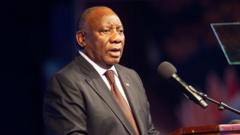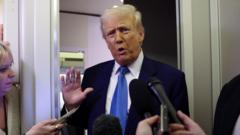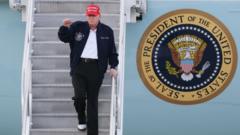**In an unfolding economic struggle, both the United States and China are navigating complex trade relations, aiming to find common ground amid rising tensions.**
**US-China Trade Tensions: The Thin Line Between Negotiation and Escalation**

**US-China Trade Tensions: The Thin Line Between Negotiation and Escalation**
**As Beijing prepares to impose new tariffs, the question remains: can both nations avert a full-blown trade war?**
Beijing’s decision to impose new tariffs on several American imports has put the two largest economies back on a precarious course, reminiscent of past trade disputes. China announced it would levy a 15% tariff on coal and liquefied natural gas products, along with a 10% tariff on crude oil, agricultural machinery, and large-engine cars imported from the US, effective February 10. This sentiment signals growing tensions, but China has historically urged negotiating avenues to resolve issues.
The timing of this announcement is crucial, as it may allow for discussions before the tariffs take effect. White House officials have reported that both nations' leaders are scheduled to converse later this week. Despite recent provocations, indications suggest China is open to dialogue, raising hopes that a resolution might be reached.
The tariffs China plans to enforce are notably more targeted than previous tariffs imposed by the Trump administration on Chinese goods. For example, the US implemented a sweeping 10% tariff on all Chinese products. China's measured approach suggests a strategic gambit, aimed at weighing the potential repercussions without overextending its economic commitments.
Moreover, certain strategic advantages may influence China's actions during this tense period. Historically, President Xi Jinping has aimed to stabilize his country's economy, which may make him cautious about provoking further conflict with the US.
The prospect of negotiations also adds layers of complexity. While Trump aims to secure advantageous agreements for the US, he faces the challenge of dealing with a more assertive Beijing, which has solidified its status as a leading trade partner for numerous nations globally. The dynamics have shifted since their previous negotiations, raising the stakes for both leaders.
In evaluating trade strategies, the Chinese economy has evolved, with a decreased reliance on international trade, thereby potentially insulating itself from tariff impacts. Current imports and exports constitute a smaller segment of China's GDP compared to prior decades. Notably, the potential for Trump to escalate tariffs poses a threat, and as fears of a trade war simmer, Beijing has signaled readiness for broader retaliatory measures beyond mere tariffs.
Reflecting on past encounters between the two nations, it's clear that historical agreements have often led to disarray. A significant trade agreement in 2020 faded in the wake of the COVID-19 pandemic, which has since exacerbated US-China trade dynamics, inflating the current trade deficit.
As businesses globally brace for potential outcomes, the effectiveness of discussions between Trump and Xi holds the key. Should tit-for-tat tariffs return, strategists agree that China will need to explore a variety of countermeasures to withstand increasing economic pressure. The coming week will be critical for both nations as the specter of an impending trade war looms large.























